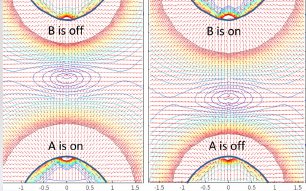OPTIMIZED MAGNETIC POLES DESIGNING – SIMULATION WORK
 Rapid and precise manipulation of magnetic beads on the nano and micro scales is essential in many biosensing applications, such as separating target molecules from background molecules and detecting specific proteins and DNA sequences in plasma.
Rapid and precise manipulation of magnetic beads on the nano and micro scales is essential in many biosensing applications, such as separating target molecules from background molecules and detecting specific proteins and DNA sequences in plasma.
Accurately moving magnetic beads back and forth requires at least two adjustable magnetic field gradients. Unlike permanent magnets, electromagnets are easy to design and can produce strong and adjustable magnetic field gradients without mechanical motion, making them desirable for use in robust and safe medical devices. However, using multiple magnetic field sources to manipulate magnetic beads presents several challenges, including overlapping magnetic fields, added bulk, increased cost, and reduced durability.
We have done, in our lab, a thorough analysis, including analytical calculations, numerical simulations, and experimental measurements, of using two electromagnets to manipulate magnetic beads inside a miniature glass cell. We analyzed and experimentally demonstrated different aspects of the electromagnets’ design, such as their mutual influence, the advantages and disadvantages of different pole tip geometries, and the correlation between the electromagnets’ positions and the beads’ aggregation during movement. Finally, we have devised a protocol to maximize the magnetic forces acting on magnetic beads in a two-electromagnet setup while minimizing the electromagnets’ size. We used two such electromagnets in a small footprint magnetic modulation biosensing system and detected as little as 13 ng/L of recombinant Zika virus antibodies, which enables detection of Zika IgM antibodies as early as 5 days and as late as 180 days post symptoms onset, significantly extending the number of days that the antibodies are detectable.
In November 15th, 2019, our paper on the analysis of electromagnets’ design, their mutual influence, the advantages and disadvantages of different pole tip geometries, and the correlation between the electromagnets’ positions and the beads’ aggregation during movement was published at the jornal "Micromachines" of MDPI as a part of a special issue "Magnetic Biosensors".
The paper, entitled 'Configuration and Design of Electromagnets for Rapid and Precise Manipulation of Magnetic Beads in Biosensing Applications', can be found in the Publications section, and at DOI: 10.3390/mi10110784.
